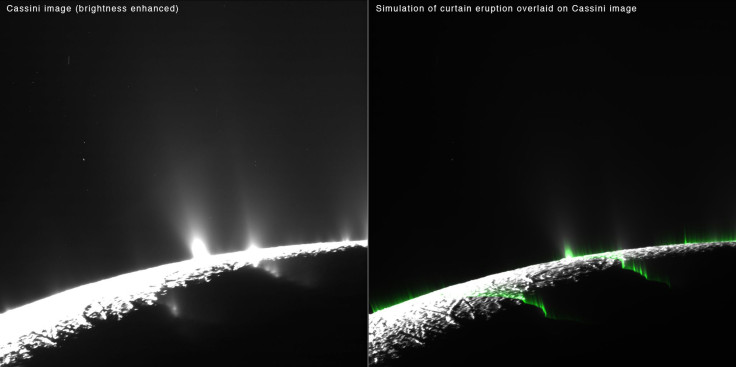On Saturn's Moon Enceladus, Water Vapor Erupts In Giant Curtains: Study

In 2005, NASA’s Cassini-Huygens spacecraft found evidence of an icy spray issuing from the southern polar region of Saturn’s sixth-largest moon, Enceladus. Now, just two months after scientists confirmed the presence of hydrothermal activity on the moon, researchers have claimed that the eruption of water vapor on its surface might be in the form of broad, curtain-like sheets, rather than discrete jets.
“We think most of the observed activity represents curtain eruptions from the ‘tiger stripe’ fractures, rather than intermittent geysers along them,” Joseph Spitale, a Cassini mission participating scientist and senior scientist at the Planetary Science Institute in Tucson, Arizona, said, in a statement, referring to prominent wavy fractures along the moon’s surface. “Some prominent jets likely are what they appear to be, but most of the activity seen in the images can be explained without discrete jets.”
According to a study published Thursday in the journal Nature, these "phantom jets" seen in simulated images produced by scientists line up perfectly with some of the features seen in real Cassini images. This means that the discrete geysers that scientists have observed on Enceladus are, in fact, an optical illusion created in places where these curtains fold against one another. This illusion is also responsible for creating regions of phantom brightness when viewers are looking through the folds of watery curtains.
“The viewing direction plays an important role in where the phantom jets appear,” Spitale said, in the statement. “If you rotate your perspective around Enceladus’ South Pole, such jets would seem to appear and disappear.”
On Earth, these curtain eruptions occur in regions of volcanic activity such as Hawaii, Iceland and the Galapagos Islands. However, unlike Enceladus’ watery curtains, these are curtains of fire.
Enceladus is believed to be covered with a layer of ice about 19 miles to 25 miles thick. Evidence strongly suggests that the moon harbors a six-mile-deep ocean, with temperatures reaching up to 194 degrees Fahrenheit below its thick, icy surface, making it a prime location to look for extraterrestrial life.
© Copyright IBTimes 2024. All rights reserved.






















